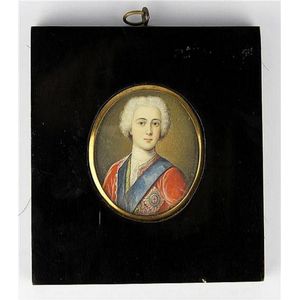French Art Deco Hair Comb with Diamantes
You must be a subscriber, and be logged in to view price and dealer details.
Subscribe Now to view actual auction price for this item
When you subscribe, you have the option of setting the currency in which to display prices to $Au, $US, $NZ or Stg.
- Celluloid - In 1864 an American scientist by the name of Parkes mixed camphor with nitrocellulose, etc. The result was what came to be known as "celluloid", the first form of plastic, and a product for which Parkes could find no use.
Some time later when the supplies of ivory for making billiard balls were becoming difficult to obtain, an inventor produced a perfect billiard ball from a mould using "celluloid".
Toys, dolls and other products such as combs, cutlery handles and costume jewellery made from celluloid began appearing on the market from 1913 and continued to do so until the early 1950s by which time it was superseded by more modern products due to safety concerns because it was highly flammable and brittle product. - Circa - A Latin term meaning 'about', often used in the antique trade to give an approximate date for the piece, usually considered to be five years on either side of the circa year. Thus, circa 1900 means the piece was made about 1900, probably between 1895 and 1905. The expression is sometimes abbreviated to c.1900.
- Art Deco Period - The Art Deco period was a cultural movement that emerged in the 1920s and 1930s, and was characterized by its emphasis on modernism, luxury, and elegance. The name "Art Deco" comes from the Exposition Internationale des Arts Décoratifs et Industriels Modernes, a large exhibition held in Paris in 1925 that showcased the latest trends in decorative arts.
Art Deco was a reaction against the ornate and elaborate styles of the previous era, and reflected a new modern sensibility. It was characterized by streamlined, geometric shapes, bright colours, and the use of new materials such as chrome, glass, and Bakelite. Art Deco designers sought to create a sense of luxury and sophistication, often incorporating expensive materials such as ivory, marble, and rare woods.
Art Deco had a significant impact on a wide range of artistic fields, including architecture, fashion, graphic design, and interior design. Some of the most iconic examples of Art Deco architecture include the Empire State Building in New York City, the Hoover Building in London, and the Palais de Chaillot in Paris.
The Art Deco period came to an end in the 1940s, as World War II and changing cultural trends led to a shift in artistic styles. However, Art Deco remains an important influence on design and art, and continues to be celebrated for its modernist sensibility and glamorous aesthetic.
This item has been included into following indexes:
Visually similar items

A Salviati tri-colour glass vase, Italian, dated 2004 acid etched Salviati 2004 to the base 25.5 cm high

A gold and black opal ring, 2.66 carat, 18ct yellow gold

A gold signet ring, the oval form top with tapering rounded style band. 18 carat yellow gold. Made by Kozminsky. Ring size L-M.

Miniature portrait of a late 18th century nobleman set in a timber frame. Condition good, minor wear. Length 14.3 cm
